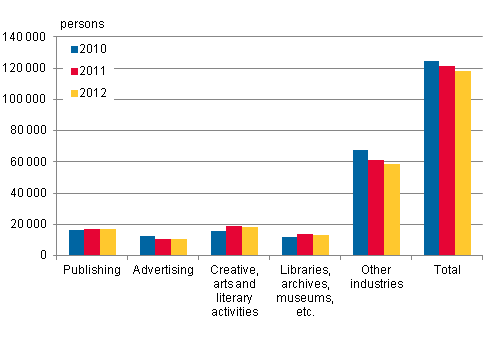Published: 23 August 2013
Employment in cultural activities weakened from 2010
Employment has weakened in cultural activities by over five per cent from 2010 to the end of 2012. In 2010, the activities employed approximately 117,860 people against around 124,480 in 2010. Employment dropped most in advertising, by around 2,300 employed persons. Employment in advertising was only about 10,400 in 2012.
Employed labour force in cultural industries in 2010 to 2012

Among other cultural activities, artistic and literary creation and interpretation in turn increased. When in 2010 the number of employed persons was around 15,700, it was already about 18,300 in 2012.
Libraries, archives, museums and other cultural activities and operation of historical sites and buildings and similar visitor attractions also employed better in 2012 than in 2010. The number of employed persons went up by 1,200 and was approximately 13,200 at the end of 2012.
Publishing employed around 17,230 persons in 2012, while in 2010 this figure was about 16,610.
Other cultural activities dropped by an average of 13 per cent from 2010 to 2012, when they employed around 58,700 persons.
These data appear from the Labour Force Survey. The Labour Force Survey is a sample survey that describes employment and unemployment based on individual interviews. The information obtained in this way describes better the actual total numbers of those employed in cultural occupations and activities than the information based on registers
The industrial classification used is the Standard Industrial Classification 2008, whose data are not comparable with the employment data produced with the Standard Industrial Classification 2002. According to the new Standard Industrial Classification and EU recommendations, additions have been made to cultural activities. A detailed explanation of the new activities is given in the review under Definition of culture from the data file
However, the development of employment in cultural occupations has been better than that of total employment. From 2005, it has improved by over 15 per cent and the number of employed persons in 2012 was more than 83,000. Growth from the previous year amounted to over two per cent. During the corresponding period, total employment has improved by just around 3.4 per cent.
The development has been particularly favourable for graphic, art and craft designers, among whom employment has improved by around 30 per cent from 2005. However, employment has dropped considerably from 2011 to 2012, by around 16 per cent. The number of employed persons in 2012 was approximately 10,450.
Employment in artistic occupations has also improved from 2005. In 2012, the number of employed persons was around 11,718, which was nearly eight per cent more than in 2005. Artistic occupations include stage and film directors, actors, singers and dancers, composers, clowns, magicians, acrobats, night-club and related musicians and artists.
The number of journalists was in 2012 around 13,718, nearly five per cent fewer than in 2005. Their number fell by a couple of per cent from 2011 to 2012
Data on employment numbers in occupations are produced with the Classification of Occupations 2001, although a newer Classification of Occupations is used in the Labour Force Survey. By using an older classification, it has been possible examine a longer period than by adopting the new classification.
Source: Cultural statistics 2012, Statistics Finland
Inquiries: Kaisa Weckström 09 1734 2348, kulttuuri.tilastokeskus@stat.fi
Director in charge: Riitta Harala
Publication in pdf-format (297.9 kB)
- Reviews
- Tables
-
Tables in databases
Pick the data you need into tables, view the data as graphs, or download the data for your use.
Appendix tables
- Figures
Updated 23.8.2013
Official Statistics of Finland (OSF):
Culture [e-publication].
ISSN=2341-7404. Cultural Employment in Finland 2012. Helsinki: Statistics Finland [referred: 29.12.2025].
Access method: http://stat.fi/til/klt/2012/01/klt_2012_01_2013-08-23_tie_001_en.html

